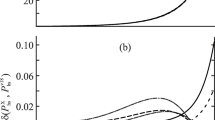Abstract
A new extended corresponding-states method for the prediction of high-density states for pure fluids is presented. The method incorporates the use of molecular shape factors. This approach requires accurate equations for the saturated-liquid density and the vapor pressure for the fluid in question. In addition, an equation of state for the vapor phase is also required. With this information, the molecular shape factors are calculated on the saturated-liquid line of the fluid being predicted, and they are assumed to be constant in the high-density, single-phase region along isotherms. This property prediction method is well suited for application to any fluid that has an equation of state valid in the vapor phase. Modern equations of state for nitrogen and oxygen were used to define properties of reference fluids in the development and testing of this new method. Experimental data for liquid ethylene were used to verify the accuracy of the new prediction method. Tests have shown that this approach predicts high-density data accurately to approximately six times the critical pressure and up to 85 % of the critical temperature. The results of these tests are presented and discussed.
Similar content being viewed by others
Abbreviations
- P :
-
Pressure
- R :
-
Gas constant (8.31434 J· mol−1 · K−1)
- v :
-
Specific volume
- T :
-
Temperature
- θ :
-
Temperature shape factor
- ψ :
-
Pressure shape factor
- φ :
-
Volume shape factor
- ν :
-
Fugacity coefficient
- ρ :
-
Density
- σ :
-
Saturation
- c:
-
Critical parameter
- i :
-
Fluid being predicted
- j :
-
Reference fluid
- r:
-
Reduced by the critical property
References
J. W. Leach, Ph.D. dissertation (Rice University, Houston, Tex., 1967).
J. C. G. Calado, P. Clancy, A. Heintz, and W. B. Street,J. Chem. Eng. Data 27:376 (1982).
G. C. Straty,J. Chem. Therm. 12:709 (1980).
R. T. Jacobsen, R. B. Stewart, and M. Jahangiri,J. Phys. Chem. Ref. Data 15:735 (1986).
R. B. Stewart, R. T Jacobsen, and W. Wagner, Submitted for publication.
R. Schmidt and W. Wagner,Fluid Phase Equil. 19:175 (1985).
M. Jahangiri, R. T. Jacobsen, and R. B. Stewart,J. Phys. Chem. Ref. Data 15:593 (1986).
S. G. Penoncello, Ph.D. dissertation (University of Idaho, Moscow, 1986).
Author information
Authors and Affiliations
Rights and permissions
About this article
Cite this article
Penoncello, S.G., Stewart, R.B. & Jacobsen, R.T. The prediction of high-density thermodynamic states using molecular shape factors. Int J Thermophys 9, 975–983 (1988). https://doi.org/10.1007/BF01133265
Issue Date:
DOI: https://doi.org/10.1007/BF01133265




